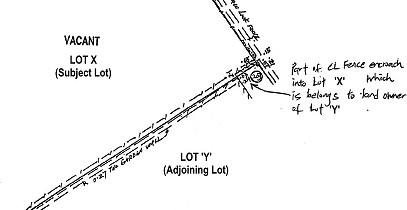2008
2008
Case No: 1/2008
Failure of RS to Detect Additional Encroachment onto Subject Site under Survey
The Case
1 A complaint was lodged against the Registered Surveyor (RS) on his failure to detect additional encroachments onto a site which was a subject of a sale. These additional encroachments include part of a staircase and part of a wall from an adjoining lot.
2 The submitted sketch had only listed an encroachment by a small portion of the chain link fence of the adjoining lot as shown in Sketch 1 below:

The updated sketch made by the RS subsequently is as shown in Sketch 2. The additional encroachments that were overlooked earlier are highlighted.

Irregularities Established
3 The irregularities established by the IC were:
(i) Omission of encroaching staircase
(ii) Garden wall was not straight throughout as documented because
a. The end stretch is recessed
b. It is kinked at the mid-length
(Refer to sketch 2)
(iii) The garden wall was only 0.15m thick instead of 0.27m as documented
(iv) The garden was found to be encroaching by 0.14m at the corner before the recess when it was earlier documented as non-encroaching
(v) Omission of an extension of the rear retaining wall onto the subject lot.
Some of the Investigation Committee’s Comments for Reference
4 The following are some comments by the Investigation Committee for references.
(a) The creepers growing on the fence could have affected visibility but they can be removed without much difficulty. It is a common situation for field assistants. The visual obstruction by the creepers can only be a mitigating factor but not a permissible excuse.
(b) Registered Surveyor’s misinterpretation or misunderstanding of verbal statements made by clients can at best be a mitigation factor. The Registered Surveyor should make the effort to clarify the issues relating to his survey to ensure they are resolved.
(c) When the Registered Surveyor signed the documents, he is responsible and liable for the correctness of the content in the documents.
(d) Even if his field assistant missed out some details due to the site condition, the Registered Surveyor is still accountable, if not liable, for the omissions.
(e) On the thickness of the wall, adequate visual inspection should have been done to confirm the uniformity of the wall thickness throughout the wall.
Decision of the Land Surveyors Board
5 As the matters were principally cadastral works in relation to the Chief Surveyor’s Directives, the Land Surveyors Board referred the findings to the Chief Surveyor. The Land Surveyors Board advised the Chief Surveyor that:
(a) The omissions and errors in the course of the survey had occurred as a result of deficiencies in field survey in which procedure and practices to the conduct of cadastral surveys in the Chief Surveyor’s Directives, in particular paragraphs 2.3.1(c) and 3.5(d), had not been complied with
(b) There had been technical oversights both in office and field practices leading to such omissions
(c) There was a lack of personal supervision when carrying out the cadastral survey
6 Consequentially, the Chief Surveyor issued a stern warning to the Respondent that:
(a) He is required to be fully aware of and to comply with all Chief Surveyor’s Directives and circulars
(b) He is to personally direct and supervise his staff carrying out cadastral survey
(c) He is reminded not to repeat such offences in contravention of directives, circular and related legislations.
Note:
As the Land Surveyors Board is bound and empowered by the Land Surveyors Act, its enforcement of the Act may not necessarily be similar to the Chief Surveyor’s.

